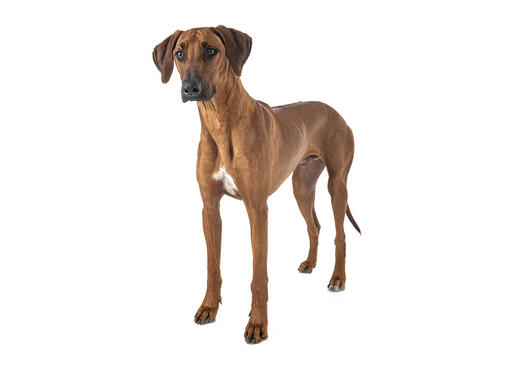
A versatile, athletic hound, the Rhodesian Ridgeback is distinguished by a ridge that runs down his back where the hair grows opposite the coat. This loyal, courageous and intelligent breed is an exceptional companion and watchdog. Sociable and affectionate, the Rhodesian Ridgeback has an innate desire to be close to his human companions. His sleek, glossy coat sheds lightly and requires minimal grooming.
DID YOU KNOW? The Rhodesian Ridgeback is also called the African Lion Hound because the breed originally was used to hunt lions in South Africa.
ALSO KNOWN AS: African lion dog, African lion hound
The need-to-know
- Dog suitable for experienced owners
- Extra training required
- Enjoys active walks
- Enjoys walking one to two hours a day
- Large dog
- Minimum drool
- Requires grooming once a week
- Non hypoallergenic breed
- Quiet dog
- Guard dog. Barks, alerts and it's physically protective
- May require training to live with other pets
- May require training to live with kids
Personality

The Rhodesian Ridgeback is a strong, powerful dog that can be determined and stubborn. Although quite friendly and confident at home, they are very wary of strangers - human and canine. Not the ideal breed for the novice owner, they need experienced handling and training, together with early, thorough and ongoing socialisation.
History and Origins

This is a dog who has been known as the African Lion Dog which gives a good indication of what this powerful hound was originally bred to do. When European settlers came to southern Africa in the 17th century, they brought their large guarding dogs with them - a mixture of mastiffs, scenthounds and Great Danes - to protect their farms, and looked with scorn on the local ridge-backed dogs whom they often shot on sight. In time however they realised that these dogs were perfectly suited to the climate and had a resistance to tropical diseases, and so instead of killing them started to breed them with their own dogs to produce what they found to be the perfect breed for pursing African wild game. The resulting dogs were taken north to Rhodesia where they were further developed and worked with big games hunters who used them in small packs to hunt lions and leopards. By the 1920s the breed had become standardised and their popularity began to grow around the world.
Nutrition and Feeding

Large breed dogs, as well as having large appetites, benefit from a different balance of nutrients including minerals and vitamins compared to smaller-breed dogs. The Rhodesian Ridgeback is prone to bloating and stomach problems; smaller, more frequent meals can help minimise this risk. Check out our dog feeding guidelines for more information.
Exercise

The Rhodesian Ridgeback requires a couple of hours of daily exercise as an adult. Rhodesian Ridgebacks have strong hunting instincts, so should be in a safe open space away from other dogs before let of the lead - or else have long on-lead walks.
Ideal Owner

The Rhodesian Ridgeback would suit an experienced owner with a large property who will enjoy training and working with a fairly challenging but highly rewarding dog. The ideal owner will also need to be able to cope with a dog devoted and affectionate to them, but possibly not to anyone else.
Other Information

Health and common issues
The Rhodesian Ridgeback is predisposed to a particular inherited defect involving the spine (dermoid sinus) and all puppies should be screened at birth for this. As with many breeds they can also suffer from hip dysplasia (a condition that can lead to mobility problems). Hip scoring of dogs prior to breeding is therefore important.
Space requirements
This is a dog who needs a large property and a securely fenced garden in a rural location, or with plenty of open space for daily exercise.
Training rhodesian ridgebacks
Plenty of socialisation and dog training is needed to ensure this dog is a safe member of canine society. With consistent reward-based training, they can master a reliable recall and walking on the lead - along with other obedience exercises. But be aware that they can be selective in their obedience when faced with distractions.
Best family dog breeds
The Rhodesian Ridgeback is not an ideal family dog. Although he can be very affectionate towards their own children, they may not be tolerant of their friends. While many dogs are traditionally thought of as being good with children, all dogs and children need to be taught to get on with and respect each other, and be safe together. Even so, dogs and young children should never be left alone together and adults should supervise all interactions between them.
Did you know?
- The anatomical feature that gives the breed its name is the ridge of hair that grows down its back - and makes it instantly recognisable. This ridge is formed by the hair growing in a totally different direction to the rest of the coat and is capped at the top with two ‘crowns’ (whorls) that are directly opposite each other. This is shared by only one other (far less common) breed, the Thai Ridgeback.
- This may however be more than just an interesting coat pattern. Some researchers have found a correlation between the ridge and a congenital skin condition known as ‘dermoid sinus’ – although this is fairly rare. Some more romantic breeders however say the ridge is “where God sewed them up after stuffing them”!